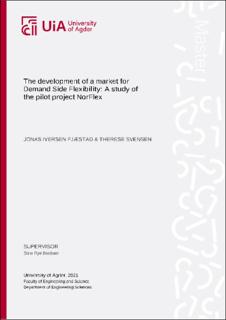| dc.contributor.author | Fjæstad, Jonas Iversen | |
| dc.contributor.author | Svensen, Therese | |
| dc.date.accessioned | 2021-10-20T07:01:38Z | |
| dc.date.available | 2021-10-20T07:01:38Z | |
| dc.date.issued | 2021 | |
| dc.identifier.citation | Fjæstad, J. I. & Svensen, T. (2021) The development of a market for Demand Side Flexibility: A study of the pilot project NorFlex (Master's thesis). University of Agder, Grimstad. | en_US |
| dc.identifier.uri | https://hdl.handle.net/11250/2823975 | |
| dc.description | Master's thesis in Industrial economics and technology management (IND590) | en_US |
| dc.description.abstract | Demand side flexibility (DSF) is believed to have positive value for the power system. DSF could solve the problems the power grid is facing due to increased electricity consumption and increased production from intermittent renewable energy sources. This is done by enabling de-mand side participation in the value chain. NorFlex is a pilot project testing and validating the DSF value chain. This thesis follows the NorFlex project, analyzing the potential value gain of DSF. The following problem statement is answered: In a developing market for Demand Side Flexibility, what is the potential for value gain? The research is designed as a case study where NorFlex is the object of study. The research follows a deductive approach, analyzing the potential for value gain in the following three steps:1. Analyse the market demand for demand side flexibility, exemplified by analyzing the grid operator Agder Energi Nett2. Analyse the cost for making three representative flexible resources available in the powergrid.3. Comparing the supply and demand derived from the analysis with the market clearing at a real market situation. In steps 1-3, a combination of quantitative and qualitative data is analyzed. The data is col-lected through interviews with central participants in the NorFlex project. Secondary data is collected from public records and from the market platform NODES. The findings of this thesis show that a potential for value gain from DSF exists. The three assets analyzed have cost functions that are lower than the DSO’s upper willingness to pay. Because the potential for value gain exists, all parties in the DSF value chain can extract value and benefit from DSF trading. However, quantifying the exact value gain requires specific evaluation of the geographical location, grid level, and weather. The demand and cost of supplying DSF will vary with these conditions, as will the price. With an increased demand for DSF and a tendency of decreased cost of acquiring relevant assets, the future development of the DSF looks promising. | en_US |
| dc.language.iso | eng | en_US |
| dc.publisher | University of Agder | en_US |
| dc.rights | Attribution-NonCommercial-NoDerivatives 4.0 Internasjonal | * |
| dc.rights.uri | http://creativecommons.org/licenses/by-nc-nd/4.0/deed.no | * |
| dc.subject | IND590 | en_US |
| dc.title | The development of a market for Demand Side Flexibility: A study of the pilot project NorFlex | en_US |
| dc.type | Master thesis | en_US |
| dc.rights.holder | © 2021 Jonas Iversen Fjæstad & Therese Svensen | en_US |
| dc.subject.nsi | VDP::Samfunnsvitenskap: 200::Økonomi: 210 | en_US |
| dc.subject.nsi | VDP::Teknologi: 500::Elektrotekniske fag: 540::Elkraft: 542 | en_US |
| dc.source.pagenumber | 114 | en_US |

